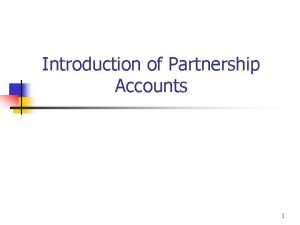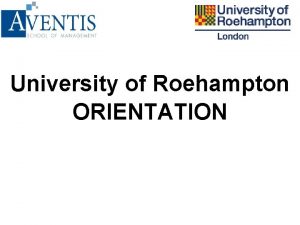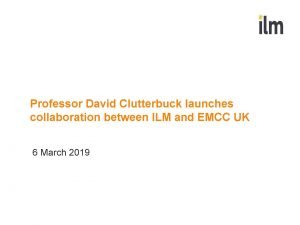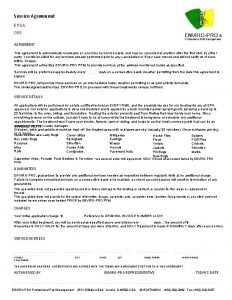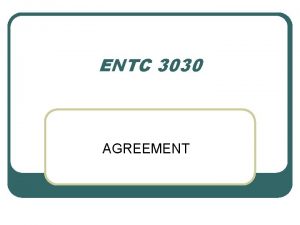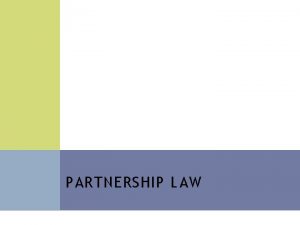Changes in partnership agreement Changes in partnership agreement













- Slides: 13

Changes in partnership agreement

Changes in partnership agreement First: The admission of a new partner. Second: The withdrawal of a partner.

First : The admission of a new partner A new partner may join a partnership by one of two ways: 1 - Presentation of investment in the partnership. In this case the capital and the assets of the partnership are going to be increased. 2 - Purchase of interest of old partners. In this case the capital of the partnership will not be changed since the transaction is a personal transaction between the partners. (However, sometimes the partners agree to revaluate the assets and liabilities).

(1)Presentation of investment in the partnership: In this case the partner may provide cash or other assets to have a share in the capital of the partnership. Therefore, the accounting treatment is using one of the following methods: 1 - The goodwill method. 2 - The bonus method. Knowing that the goodwill or the bonus may be to the old partners or the new partner. First : The goodwill method: The following steps should be applied: 1) Determine the total paid in capital (old partners capital + capital provided by the new partner). 2) Determine the total required capital (capital after admission) and the partners share in this capital. 3) The goodwill is the difference between the total paid in capital and required capital of the partnership. - If the two figures are equal so there is no goodwill. Who will take the goodwill? ?

1 - The goodwill to the old partners: If their capital before the admission is less than their capital after the admission. 2 -The goodwill to the new partner : If his paid in capital is less than his share in the capital after the admission. Second: The bonus method: If the partners do not change the book values of assets before the admission, here we can use the bonus method and the bonus may be to the new partner or to the old partners as follows: 1 - The bonus to the old partners: If the amount paid by the new partner more than his share in the capital 2 - The bonus to the new partner: If the amount paid by the new partner less than his share in the capital

Example (1) A and B are partners in a general partnership. They share the net income on a ratio of 2: 3. Partner (C) is to be admitted to the partnership for an interest of 1/3 in capital, and 25% of net income. Before admission, the partners had the following capital balances: A B Capital 30000 90000 Partner (C) will present the following assets: Cash 10000 Building 30000 The partners agreed that the capital after admission will be 180, 000. Required: Prepare the journal entry to record the admission of partner (C) using the goodwill method.

Paid in capital Capital after admission Partner A 30000 Partner B 90000 Partner C 40000 60000 Total 160000 180000 (180000 * 1/3) - The total paid in capital (160000) < total capital after admission (180000) so there is goodwill. -The paid in capital of the new partner (40000) < his share in the capital after admission (60000 = 180000 * 1/3) so there is a goodwill of 20000 and belong to the new partner Dr Cash 10000 Building 30000 goodwill 20000 Capital, C Cr 60000 Share in the capital after admission

Example (2) A and B are partners in a general partnership. They share the net income on a ratio of 2: 3. Partner (C) is to be admitted to the partnership for an interest of 1/3 in capital, and 25% of net income. Before admission, the partners had the following capital balances: A B Capital 30000 60000 Partner (C) will present : Cash 50000 The partners agreed that the capital after admission will be 150, 000. Required: Prepare the journal entry to record the admission of partner (C) using the goodwill method.

Paid in capital Capital after admission Partner A 30000 Partner B 60000 Partner C 50000 Total 140000 150000 (150000 * 1/3) • The total paid in capital (140000) < total capital after admission (150000) so there is goodwill. • The paid in capital of the new partner (50000) = his share in the capital after admission (50000 = 150000 * 1/3) So the goodwill of 10000 belongs to the old partners. We allocate the goodwill using the ratio of profit and loss of old partners before the admission Partner A’s share = 10000 *( 2/5)= 4000 (A’s capital after admission = 30000 + 4000 = 34000) Partner B’s share = 10000 *( 3/5) = 6000 (B’s capital after admission = 60000 + 6000 = 66000) Dr Cash 50000 goodwill 10000 Capital, (C) Cr 50000 Share in the capital after admission Capital, A 4000 Share in the goodwill Capital, B 6000 Share in the goodwill

Example (3) A and B are partners in a general partnership. They share the net income on a ratio of 2: 3. Partner (C) is to be admitted to the partnership for an interest of 25%in capital, and net income. Before admission, the partners had the following capital balances: A B Capital 40000 80000 Partner (C) will present : Cash 50000 Required: Prepare the journal entry to record the admission of partner (C) using the bonus method.

Paid in capital Capital after admission Partner A 40000 Partner B 80000 Partner C 50000 42500 Total 170000 (170000 * 25%) When we use the bonus method , it means that the total paid in capital must equal the total capital after admission, so it equals (170000). • The paid in capital of the new partner (50000) > his share in the capital after admission (42500 = 170000 * 25%) so there is a bonus of 7500 (50000 – 42500) to the old partners. The bonus will be allocated on a ratio of 2: 3 and will be added to their capitals. (A) = 7500 *(2/5) = 3000 (A’’s capital after admission = 50000 + 3000 = 53000) (B) = 7500 * (3/5) = 4500 (B’s capital after admission = 70000 + 4500 = 74500) Dr Cash Capital, C Cr 50000 42500 (Share in the capital after admission) Capital, A 3000 (Bonus added) Capital, B 4500 (Bonus added)

Example (4) A and B are partners in a general partnership. They share the net income on a ratio of 2: 3. Partner (C) is to be admitted to the partnership for an interest of (1/3) in capital, and 25% of net income. Before admission, the partners had the following capital balances: A B Capital 40000 80000 Partner (C) will present : Cash 30000 Required: Prepare the journal entry to record the admission of partner (C) using the bonus method.

Paid in capital Capital after admission Partner A 50000 Partner B 70000 Partner C 30000 50000 Total 150000 (150000 * 1/3) When we use the bonus method , it means that the total paid in capital must equal the total capital after admission, so it equals (150000). • The paid in capital of the new partner (30000) < his share in the capital after admission (50000 = 150000 * 1/3) so there is a bonus of 20000 (50000 – 30000) to the new partner(C). • The bonus will be allocated on a ratio of 2: 3 and will be deducted from the old partners’ capital. (A) = 20000 *(2/5) = 8000 (A’s capital after admission = 50000 - 8000 = 42000) (B) = 20000 * (3/5) = 12000 (B’s capital after admission = 70000 - 12000 = 58000) Dr Cash Cr 30000 Capital, A 8000 (Bonus deducted) Capital, B 12000 (Bonus deducted) Capital, C 50000 (Share in the capital after admission)
 How to sign microsoft partner agreement
How to sign microsoft partner agreement Epa economic partnership agreement
Epa economic partnership agreement Local partnership agreement
Local partnership agreement Pezzutto v dreyer
Pezzutto v dreyer Affirmative and negative agreement
Affirmative and negative agreement Physical change chemistry
Physical change chemistry Elizabeth mulroney
Elizabeth mulroney Sare partnership grant
Sare partnership grant Stour valley and poole partnership
Stour valley and poole partnership Closing entries in partnership
Closing entries in partnership Introduction to partnership accounts
Introduction to partnership accounts Bedside clinical guidelines partnership
Bedside clinical guidelines partnership Roehampton referencing guide
Roehampton referencing guide Clutterbucks model
Clutterbucks model










